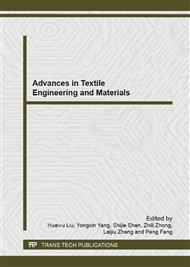p.49
p.53
p.57
p.62
p.67
p.76
p.80
p.85
p.90
Relationship between Structure and Properties of High Tenacity Polyamide 6 upon Different Draw Ratios and Heat Styling Temperatures
Abstract:
This paper has studied the structure and property of high tenacity polyamide 6 upon different draw ratios and heat styling temperature process conditions, characterized with wide-angle X-ray diffraction (WAXD), sound velocity method, Fourier transform infrared (FTIR) spectroscopy, amino-terminated content determination and essential property texts such as the absorption of moisture and dyeing. It was demonstrated that increasing the draw ratio (DR) and heat styling temperature were conducive to crystal-to-crystal transformation and stabilizing the internal structure of fibers. The temperature played a significant role in orientation of high tenacity polyamide 6, particularly subjected to a higher heat styling temperature, owing to its thermo plasticity. And increasing the draw ratio and heat styling temperature were both conducive to the tensile property, but little beneficial impact on moisture property. The high tenacity polyamide 6 exert a good effect on absorption of moisture and acid dye, and for dyeing the effects of hydrogen-bond as well as the van der Waals’ force play a significant role in dye pickup, especially in the high tenacity polyamide 6 upon different draw ratios.
Info:
Periodical:
Pages:
67-75
Citation:
Online since:
December 2012
Authors:
Price:
Сopyright:
© 2013 Trans Tech Publications Ltd. All Rights Reserved
Share:
Citation:


